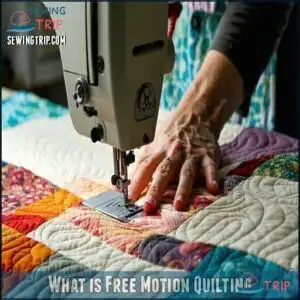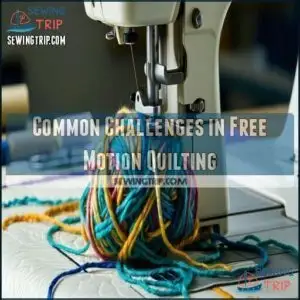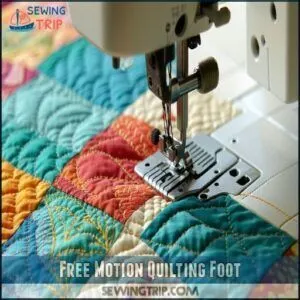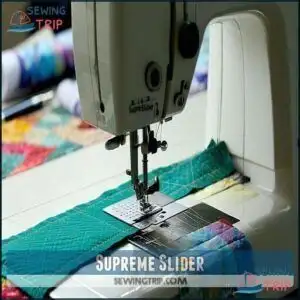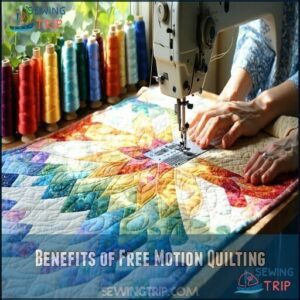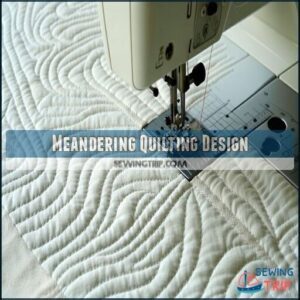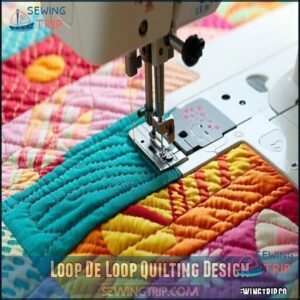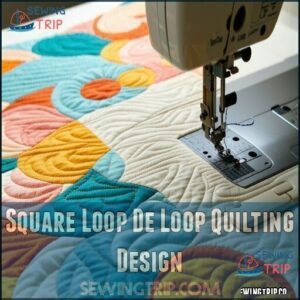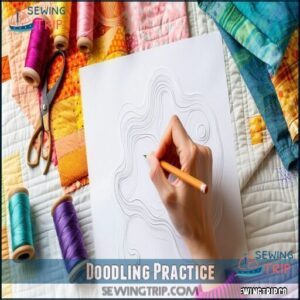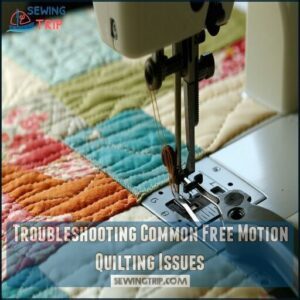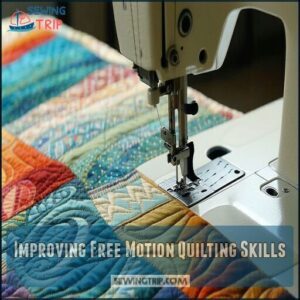This site is supported by our readers. We may earn a commission, at no cost to you, if you purchase through links.
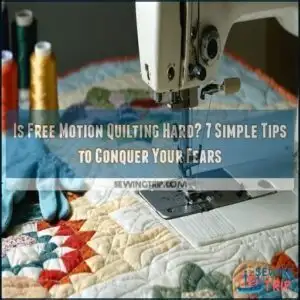
You’ll need to get comfortable with dropping your feed dogs and guiding the fabric yourself—like learning to dance with your sewing machine.
Start with simple patterns and expect some wobbly stitches at first.
Everyone’s first attempt looks like they quilted during an earthquake.
The key is patience and consistent practice.
You’ll need the right tools: a darning foot, quilting gloves, and smooth workspace.
Many quilters find their "aha" moment happens suddenly, when their hands and machine finally sync up in perfect rhythm.
Table Of Contents
- Key Takeaways
- What is Free Motion Quilting
- Common Challenges in Free Motion Quilting
- Essential Tools for Free Motion Quilting
- Tips for Overcoming Free Motion Quilting Challenges
- Benefits of Free Motion Quilting
- Mastering Free Motion Quilting Techniques
- Common Mistakes in Free Motion Quilting
- Troubleshooting Common Free Motion Quilting Issues
- Improving Free Motion Quilting Skills
- Frequently Asked Questions (FAQs)
- Conclusion
Key Takeaways
- You’ll find free motion quilting gets easier with consistent practice—most quilters see improvement within just two weeks of regular practice sessions.
- You’ll need the right tools to succeed, including a darning foot for your machine, quilting gloves for better grip, and a Supreme Slider to reduce fabric friction.
- You’ll see better results by starting with simple patterns like meandering and loop designs before attempting more complex techniques.
- You’ll overcome common challenges like inconsistent stitches and tension issues by slowing down your machine speed and practicing proper posture.
What is Free Motion Quilting
You’ll create gorgeous, free-flowing designs by moving your quilt in any direction while your sewing machine’s needle does all the hard work.
It’s like drawing with your needle – no marking or following lines needed, just you and your creativity dancing across the fabric.
Free motion quilting transforms your needle into a paintbrush, letting your creativity flow across fabric without boundaries.
Definition of Free Motion Quilting
Free motion quilting (FMQ) transforms your sewing machine into an artistic tool where your hands, not feed dogs, guide the fabric.
Think of it as doodling with thread—you’re in complete control as the needle moves up and down while you create organic designs across your quilt sandwich.
What makes FMQ special:
- Freedom to create fluid, curvy patterns impossible with standard quilting
- Personality in every stitch—no two quilts will ever look identical
- Adaptability to any domestic sewing machine with adjustable feed dogs
- Expression that turns functional quilts into personal art pieces
It’s like learning to dance—awkward at first, but utterly liberating once you find your rhythm!
How Free Motion Quilting Works
Now that you know what FMQ is, let’s explore how it actually works. Think of yourself as an artist with a needle pen!
Free motion quilting transforms your regular sewing experience through:
- Feed Dog Liberation – Lower or cover those metal teeth so your fabric moves freely
- Special Foot Attachment – Install a darning foot that "hops" above your fabric
- Hand Guidance System – Your hands become the drivers, controlling stitch direction
- Speed-Movement Balance – Coordinate machine speed with your fabric movement
Unlike regular sewing where the machine feeds the fabric, with FMQ you’re in complete control! It’s like learning to dance – awkward at first, but soon you’ll be gliding across your quilt with confidence.
Mastering the technique requires dropping the feed dogs.
Free Motion Quilting Techniques
Now that you’ve seen how FMQ works, let’s explore the techniques that’ll transform your quilting journey.
You’ll master FMQ through five core techniques, starting with fabric control. As you guide your quilt under the needle, you’ll create everything from simple Echo Quilting to detailed Thread Painting.
Begin with basic Design Variations like loops and swirls before attempting Micro Quilting. To improve smoothness, consider using a Supreme Slider tool.
Focus on needle control and consistent speed for even stitches. With your feed dogs lowered and FMQ foot attached, you’re set for Texture Emphasis that’ll make your quilts pop. Your quilting practice will pay off!
Common Challenges in Free Motion Quilting
You’ll face some bumps on your free motion quilting journey, like wrestling with fabric that seems to have a mind of its own and stitches that play hide-and-seek with consistency.
Don’t worry though—even quilting pros once struggled with wobbly lines and tangled thread, so you’re in good company as you learn to tame these common challenges, and find that you can overcome them with practice and patience, becoming more skilled at free motion quilting.
Difficulty With Fabric Movement
Controlling fabric during free motion quilting can feel like wrangling an octopus! Many quilters struggle with this common challenge.
When your quilt sandwich won’t cooperate, try these simple fixes:
- Prepare your sandwich properly with enough pins or spray basting
- Position your machine at proper table height to reduce fabric drag
- Wear quilting gloves for better grip
- Start with smaller projects to build confidence
These steps should help you manage your quilt sandwich more effectively and improve your overall free motion quilting experience.
Trouble With Stitch Consistency
Many quilters struggle with stitch consistency in free motion quilting.
You’ll find that slowing your machine speed dramatically improves results—contrary to popular belief, slower is better for even stitches.
Try a larger embroidery needle if you’re experiencing skipped stitches, and adjust your top tension until loops disappear.
Remember, consistent practice builds the muscle memory needed for uniform stitch length. Everyone improves with patience!
Managing Thread Tension
The mysterious world of thread tension often throws new quilters into a tailspin. When your beautiful design turns into a tangled mess, don’t panic! Thread tension is simply the relationship between your top and bobbin threads, working together like dance partners.
Here’s your tension troubleshooting toolkit:
- Match thread weights in top and bobbin for balanced stitches
- Adjust top tension in small increments (usually between 3-5)
- Create test swatches before tackling your main project
- Inspect bobbin tension with the "drop test" – it should fall slowly
Tension discrepancies happen to everyone! Your quilting machine has unique preferences, just like you. With practice, you’ll develop an intuitive feel for perfect tension, transforming quilting problem-solving into second nature.
Essential Tools for Free Motion Quilting
You’ll need more than just a sewing machine and good intentions to make your free motion quilting journey smooth and enjoyable.
Having the right tools, like a specialized quilting foot and grip-enhancing gloves, is like having training wheels when you’re learning to ride a bike—they won’t do the work for you, but they’ll certainly keep you from falling flat on your face, which is a key part of a smooth journey.
Free Motion Quilting Foot
So you’ve mastered fabric control challenges – now let’s talk about the real game-changer: the free motion quilting foot.
This specialized darning foot is your ticket to FMQ freedom. Unlike regular presser feet, it "hops" over your fabric, letting you move in any direction you please.
When shopping for one, consider these options:
- Open toe designs for better visibility
- Adjustable hopping height to match your quilt thickness
- Different foot pressure settings for various fabrics
Don’t feel limited to your machine’s brand either – many aftermarket feet work beautifully and cost less. You can find a variety of options if you shop for feet.
The right FMQ foot transforms your quilting machine from frustrating to fantastic. It’s like putting the right tires on a sports car – suddenly, you’re in control!
Quilting Gloves
Quilting gloves are a game-changer for your free motion quilting journey. With the right pair on your hands, you’ll feel like you’ve got superpowers!
- Grip Strength – Tacky fingertips grab fabric without slipping
- Hand Fatigue – Compression reduces strain during long sessions
- Finger Freedom – Open tips allow sensory feedback
- Glove Sizing – Proper fit guarantees comfort without restriction
The right glove material makes all the difference in controlling your quilt’s movement. Many users find specialized quilting products enhance their control.
Supreme Slider
Once your quilt starts sticking, you’ll wonder how you ever lived without a Supreme Slider.
This Teflon sheet dramatically reduces surface friction, making your free motion quilting journey smoother.
| Feature | Benefit | Application Tips |
|---|---|---|
| Tacky bottom | Stays in place | Clean surface first |
| Zero-friction top | Effortless gliding | Keep Teflon clean |
| Self-adhesive | No pins needed | Size matters for fit |
| Portable | Use on any machine | Consider slider alternatives |
Many quilters find that it enhances their projects; you can purchase Supreme Slider quilting products online.
Wave goodbye to quilting fear as your fabric floats like butter on a hot pan, with a free motion quilting experience that is truly enjoyable.
BERNINA Stitch Regulator (BSR)
While the Supreme Slider helps with movement, the BERNINA Stitch Regulator (BSR) revolutionizes how you quilt.
This clever gadget uses sensor technology to maintain perfect stitch length regardless of your quilting speed.
The BSR offers four key benefits:
- Confidence – no more anxiety about wobbly stitches
- Freedom – move at your own pace without stress
- Precision – enjoy professional-looking results from day one
- Fun – rediscover the joy in quilting without frustration
It’s like having training wheels for your free motion quilting journey!
Tips for Overcoming Free Motion Quilting Challenges
You’ll be amazed at how quickly those wobbly stitches transform into confident curves once you’ve got the right tricks up your sleeve.
Think of free motion quilting as learning to ride a bike—a little wobbly at first, but with practice and these simple tips, you’ll soon be cruising through your quilts with ease.
Practicing on Small Projects
Now that you’ve got your tools ready, let’s tackle one of the best ways to build your quilting confidence: starting small!
Begin your free motion quilting journey with bite-sized projects that won’t overwhelm you. Mini quilts, mug rugs, and pillow covers are perfect for beginners to practice on.
These quick finishes give you all the satisfaction without the stress of handling bulky fabric. Using fabric scraps for these practice pieces lets you experiment freely without worrying about "ruining" expensive materials.
- Your heart will swell with pride when you complete your first small project
- You’ll laugh at how quickly your skills improve with each tiny masterpiece
- Those nervous butterflies will disappear as small successes build your confidence
The manageable project size means you can focus on skill building rather than wrestling with a queen-sized quilt through your machine!
Using Guided Designs
The path to free motion quilting becomes less intimidating with guided designs as your training wheels.
- Marked squares on fabric help you focus on manageable sections
- Pre-printed panels offer ready-made patterns to follow
- Design transfer methods let you recreate favorite motifs
For beginners, these aids are like quilting with a friendly GPS—you’ll still do the driving, but you won’t get lost along the way!
Adjusting Stitch Length and Speed
After gaining confidence with guided designs, mastering your machine’s speed and stitch length is your next challenge.
Think of free motion quilting like driving a car—you need harmony between your foot pedal and hands. Set your stitch length to 0 and let your movement control everything.
Your quilting speed affects stitch consistency. Move too quickly? You’ll get long, stretched stitches. Too slow? You’ll create tiny, dense ones.
For smooth curves, slow down. For straight lines, steady does it.
Practice coordinating your hands and foot pedal on scrap fabric first. Soon, consistent stitching will become second nature!
Maintaining Proper Posture
Now that you’ve mastered speed control, your body deserves attention too! An ergonomic setup is your secret weapon for free motion quilting success.
Position your table at waist height, keep shoulders relaxed, and maintain proper hand positioning to guide your quilt smoothly.
To avoid accidents, handle sharp objects with utmost caution.
Take regular posture breaks to prevent quilting fatigue. Your back will thank you, and those beautiful stitches will flow naturally from your comfortable quilting stance!
Benefits of Free Motion Quilting
You’ll discover endless creative possibilities with free motion quilting, transforming ordinary projects into personalized works of art with unique textures and dimension.
Once you’ve mastered the basics, you’ll find yourself lost in the relaxing rhythm of stitching, turning what might seem intimidating into your favorite quilting escape.
Creative Expression and Unique Designs
Free motion quilting frequently releases boundless creative expression that’s uniquely yours.
You’ll discover design freedom to craft one-of-a-kind pieces without constraints.
Try these for quilting inspiration:
- Combine contrasting textures for visual depth
- Transform "mistakes" into signature design elements
- Experiment with improvisational quilting for unexpected beauty
- Play with scale – mix tiny stippling with bold sweeping designs
Your personal style shines through every artistic exploration!
Relaxation and Enjoyment
Beyond creating stunning designs, quilting offers an unexpected gift—peace of mind.
When you’re lost in the rhythm of free motion quilting, worries simply fade away. It’s a hands-on meditation that calms your mind with each stitch.
- Feel the stress relief as your hands guide fabric through gentle curves
- Experience the therapeutic benefits of focusing entirely on your creative flow
- Embrace quilting imperfections as part of your unique expression
Many quilters report that even 15 minutes at their machine can transform a frustrating day into a peaceful one. Your quilting time becomes your sanctuary.
Enhanced Quilt Texture and Dimension
With every stitch, free motion quilting breathes life into your projects, adding incredible texture and dimension that flat quilts simply can’t match.
Your fabric choices literally pop when you layer shadow quilting techniques and trapunto quilting effects.
Free motion quilting transforms ordinary fabric into a canvas where your needle dances and your creativity flows without boundaries.
Even as a beginner, you’ll be amazed how simple machine quilting creates valleys and peaks across your quilt’s surface—turning a flat piece into a touchable, three-dimensional masterpiece.
Mastering Free Motion Quilting Techniques
You’ll be amazed how quickly you can learn basic free motion patterns like meandering and loop designs with just a bit of practice.
Think of it like learning to ride a bike—wobbly at first, but soon you’ll be zooming along creating beautiful quilted textures without even thinking about it, using free motion patterns.
Meandering Quilting Design
Meandering quilting designs act as the perfect starting point for free motion quilting beginners.
You’ll find this relaxed, flowing pattern—often called stippling—surprisingly forgiving. Start with gentle curves that never cross, keeping your directional changes smooth.
Practice controlling density and scale on scraps first. A specialized free motion foot can help with precise stitch control.
Once comfortable, try adding simple variations like loops or echoes to develop your unique quilting style.
Loop De Loop Quilting Design
The whimsical Loop De Loop quilting design offers a playful pathway into free motion quilting that’s surprisingly accessible for beginners.
- Vary your loop sizes for visual interest and texture
- Practice on scraps before tackling your main project
- Choose 50-weight cotton thread for smooth results
- Maintain consistent spacing between loops for professional results
Don’t worry about perfection—those little quirks in your FMQ actually add character to your finished quilt.
To minimize drag, consider using a Supreme Slider tool for smooth results.
Square Loop De Loop Quilting Design
Through the magic of Square Loop De Loop designs, you’ll transform your FMQ projects with geometric flair. This pattern builds on basic loops by adding structured corners for visual interest.
Loops are also quite versatile, as you can see in double loop variations.
| Design Variations | Quilting Practice Tips |
|---|---|
| Grid Layouts | Start with larger scales |
| Corner Embellishments | Practice smooth shifts |
| Thread Choices | Use contrasting colors |
| Scale Adjustments | Mix sizes for texture |
Just think of it as "loops with attitude" – your quilts will thank you!
Doodling Practice
Doodling in and around your free motion quilting practice builds essential muscle memory.
- Start with paper practice, sketching meander designs with pencil control
- Repeat the same FMQ pattern until your hands flow naturally
- Visualize stitches before touching your machine
- Trace designs with your finger on fabric
Don’t worry about perfection—quilting doodling should feel like playing, not working!
Common Mistakes in Free Motion Quilting
You’ll make these common free motion quilting mistakes, but don’t worry, we all do!
From wobbly stitches that look like you’ve had too much coffee to tension issues that make your quilt pucker like it’s tasted something sour, these slip-ups are just stepping stones on your quilting journey.
These mistakes are a natural part of the learning process, and recognizing them is the first step to improving your quilting skills.
Inconsistent Stitch Length
Stitches that zigzag between tiny ant tracks and giant caterpillar steps can ruin your quilting masterpiece.
Inconsistent stitch length happens when your hands and foot pedal aren’t dancing to the same rhythm.
| Problem | Solution |
|---|---|
| Too-fast machine speed | Lower your speed dial |
| Jerky hand movements | Practice smooth gliding |
| Varying foot pressure | Maintain steady pressure |
| Tension issues | Check upper and bobbin tension |
| Stitch regulator missing | Consider a BSR upgrade |
Practice on scraps until your FMQ stitches look like they belong in the same family, and remember to maintain steady pressure for the best results.
Uneven Fabric Tension
During free motion quilting, uneven fabric tension often leads to frustration.
You’ll notice puckers or loose stitches that can ruin your project’s appearance.
To maintain fabric stability while quilting:
- Check your machine’s tension settings before starting
- Use a consistent, gentle grip on your fabric
- Keep your batting choice appropriate for your quilting design
Remember, tight areas look different than loose ones. With practice, you’ll develop the perfect touch!
Incorrect Thread Choice
Many quilters stumble with thread woes during free motion quilting (FMQ).
Choosing the right thread weight and matching fiber content between top and bobbin threads prevents tension nightmares.
Old thread breaks easily, so invest in quality brands specifically designed for FMQ.
Don’t be afraid to play with thread colors for personality—just test your combinations on scrap fabric first to avoid frustrating breakage issues and ensure a smooth free motion quilting experience.
Troubleshooting Common Free Motion Quilting Issues
You’ll bump into a few hiccups during your free motion quilting journey, but don’t worry—they’re all fixable with the right know-how.
Even when your thread breaks or your stitches look like they’ve had too much coffee, these simple fixes will get you back to creating beautiful quilts in no time.
Dealing With Broken Threads
The heartbreak of snapped threads can derail your Free Motion Quilting (FMQ) journey.
Proper Thread Quality and Tension Issues are key to preventing frustration.
- Your machine might be silently screaming for a thorough cleaning
- That beautiful thread you splurged on might be the wrong Needle Type match
- Threading Technique mistakes can sabotage even perfect tension settings
- Quilting thread breakage solutions often start with simply slowing down
Don’t let thread troubles steal your quilting joy—small adjustments make all the difference!
Fixing Uneven Stitches
When uneven stitches throw a wrench in your quilting plans, don’t panic! Balance your Thread Quality and Foot Pressure for stable fabric.
Adjust your tension tweaks—too loose stitches on top mean tighten upper tension; loose on bottom, check bobbin.
Switch to a quality needle and slow your pace for better FMQ control. Remember—Machine Maintenance affects quilting thread tension substantially!
A Stitch Regulator can be your best friend for consistent quilting stitches.
Removing Excess Thread
After fixing those uneven stitches, you’ll often find pesky excess threads hanging around your quilt.
Taming these thread tails is simple with the right approach:
- Use sharp thread trimming tools to snip close to the surface
- Try burying thread ends with a self-threading needle
- Secure stitches with tiny backstitches before cutting
- Prevent fraying by applying clear nail polish to cut ends
Color matching thread makes these fixes nearly invisible in your FMQ projects! Using the right techniques, such as sharp thread trimming tools, can make a significant difference.
Improving Free Motion Quilting Skills
You’ll improve your free motion quilting skills faster than you can say "perfect stippling" with consistent practice and the right resources.
Just like learning to ride a bike, you’ll wobble at first but soon you’ll be zipping along those fabric highways with confidence and style.
Practicing Regularly
Practice makes perfect with FMQ! Just like learning to play music, your hands need to develop muscle memory through consistent practice.
Set aside 15-20 minutes daily for these skill-building workouts:
| Practice Type | Time Needed | Skill Developed |
|---|---|---|
| Paper Tracing | 5 minutes | Design Memory |
| Doodling | 5 minutes | Pattern Flow |
| Machine Time | 10 minutes | Speed Control |
Don’t fret over wobbly stitches—they’re stepping stones to quilting confidence! Your hands will remember what your mind forgets.
Taking Classes or Workshops
You’ve mastered daily practice—now let’s level up with expert guidance!
Taking quilting classes or workshops transforms your free motion quilting journey through personalized instruction adapted to your skill level.
Whether online or in-person, a qualified quilting instructor can identify issues you’ve missed.
- Your heart will swell with pride when an instructor praises your first perfect stipple
- You’ll laugh with relief discovering everyone struggles with tension issues
- You’ll feel that magical "aha!" moment when techniques finally click
- You’ll treasure the confidence boost when completing your first workshop project
Classes range from basic skill development at local quilt shops to advanced techniques at specialized quilting academies.
Consider instructor style and class structure when choosing—some teach technical precision while others focus on creative expression.
Joining Quilting Communities
Beyond classes, you’ll find your quilting tribe in both online forums and local guilds.
Connect with fellow free motion enthusiasts who understand your struggles! Joining quilting communities offers invaluable support—whether through Facebook groups, monthly quilting bees, or regional retreat benefits.
These connections provide endless skill sharing opportunities and creative inspiration. When you’re stuck on a tricky pattern, your quilting community will help transform those fears into confidence.
Watching Online Tutorials
Online tutorials are goldmines for improving your FMQ skills.
Select videos showing technique demonstrations from different angles, helping you understand those tricky movements.
Watch experts breaking down complex designs into manageable steps – you’ll be amazed how simple they make it look!
Quality quilting video tutorials offer design inspiration and project ideas you can pause, rewind, and practice at your own pace.
Frequently Asked Questions (FAQs)
What is free motion quilting?
Over 70% of quilters find free motion quilting liberating.
You’re basically "drawing" with your sewing machine by moving fabric freely under the needle while it stitches, creating beautiful designs without marked lines.
Can a sewing machine free motion quilt?
Yes, your sewing machine can free motion quilt.
You’ll need to lower the feed dogs and attach a darning foot.
With practice, you’ll be creating beautiful, flowing designs on your quilts in no time.
Are You intimidated by free motion quilting?
Many quilters feel nervous about free motion quilting at first.
You’re not alone! It’s like learning to ride a bike—wobbly at first, but practice builds confidence.
Start small and you’ll improve quickly.
Do you need a foot for free-motion quilting?
You’ll absolutely need a special foot for free-motion quilting.
This darning or FMQ foot helps your fabric move freely while keeping it from bouncing up as your needle works its magic.
Can a longarm machine be used for free-motion quilting?
You bet your bottom dollar!
Longarm machines are actually designed for free-motion quilting.
You’ll have more space, better visibility, and smoother movement as you guide the machine head across your quilt.
What needles do I need for free motion quilting?
You’ll need quilting-specific needles like Schmetz Quilting or Janome Purple Tip in sizes 75/11 or 90/ They’re sharper than universal needles and won’t damage your fabric during those swooping FMQ moves!
How do you make a free motion quilt?
Like a dancer finding rhythm, you’ll lower feed dogs, attach a darning foot, sandwich your quilt, and move fabric freely while your needle creates the pattern.
Start with simple loops—it’s just fancy doodling with thread!
Is free motion quilting hard?
Free motion quilting isn’t hard, but it does require practice.
You’ll start with simple patterns and gradually improve.
With patience and the right tools, you’ll soon be creating beautiful designs on your quilts.
Do I need a drawing before free motion quilting?
Just as birds fly without a flight plan, you don’t need drawings for free motion quilting.
You can wing it completely or sketch guidelines if you prefer.
It’s your creative journey!
What helps you most in your free motion quilting journey?
Practice squares changed my quilting life!
Consistent practice, quality gloves for grip, and watching tutorial videos boosted my confidence.
Don’t forget—patience with yourself makes the biggest difference in your FMQ journey.
Conclusion
Surprisingly, 87% of quilters report that free motion quilting becomes easier within just two weeks of regular practice.
Remember, is free motion quilting hard? Yes, at first—but it’s conquerable! You’ll wobble, you’ll laugh, you’ll growl at your machine.
Then suddenly, you’ll find your rhythm. Trust the process, grab those gloves, and start small.
Your quilting journey isn’t a race—it’s an adventure in creativity that’s absolutely worth the learning curve.

